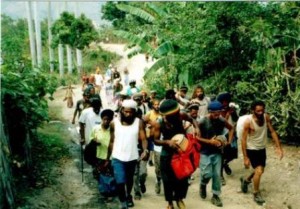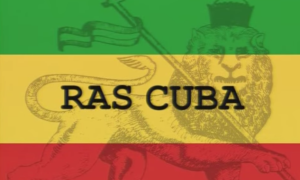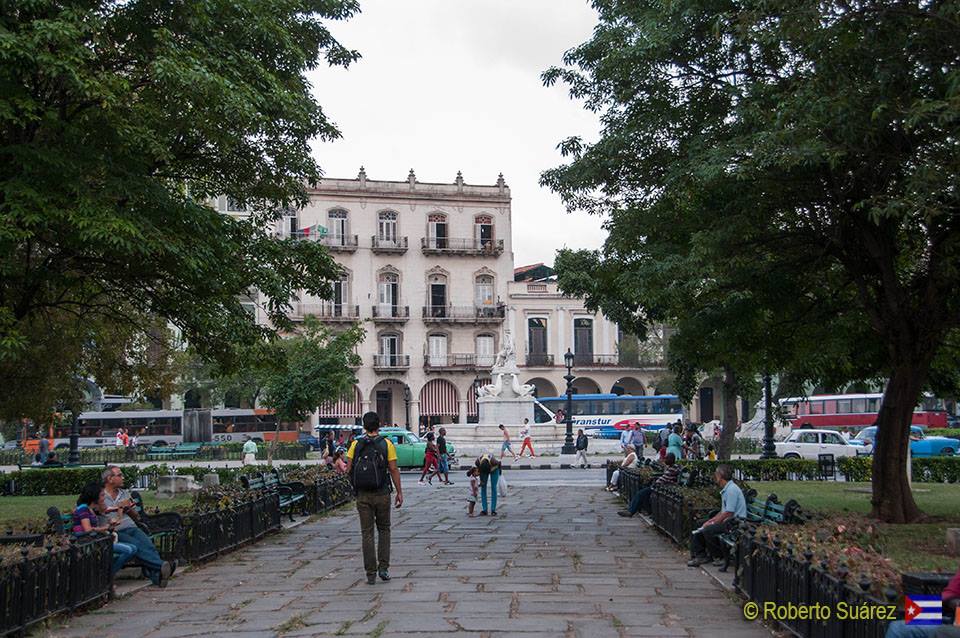THE RASTAFARI MOVEMENT IN CUBA. BOB MARLEY.
It is difficult to establish criteria regarding entry ideas Rastafari movement in Cuba before 1959. Although known entry to Cuba since 1913 thousands of West Indian immigrants, mostly Jamaicans and Haitians, it is important to stress that this migration is stopped abruptly, not recovered in the early years of the ’30s – mainly because of the global economic crisis also had an influence on Cuba -. Done that happens to coincide with the emergence of Rastafari. So it becomes very difficult to find the entrance of his ideas in those years, at least from the point of view of migration.
The cultural and religious Rastafari system reached Cuban soil since the 70s of last century, did not reach peak until 1991 when the ruling Communist Party of Cuba accepted into its ranks people of any faith or religion, it was unthinkable at the beginning, because it is valued as extranjerizante and divergent with the Cuban revolutionary process. It was really difficult for the general public and institutional authorities’ acceptance of the overnight culture of religious basis, linked to the person of the then “black God” Haile Selassie I; which idealized the African continent, “he explained.
Rastafari offered to those who approached from mainly music and religion, the possibility of positions racial assertiveness, black pride, of subversion of Eurocentric standards of beauty and the critique of white hegemony, among others.
In the young population, especially among black males and mestizo popular strata of Cuban society, where more was permeated this culture arose in Jamaica and internationally promoted by the reggae singer Bob Marley.
Marley is now one of the symbols of this group also rated by some experts as one of the many subcultures.
Dreadlocks people, as they are popularly known, have also been associated with criminality in Cuba, prostitution and marginalization.
However, they are common among the Cuban population consumption “unconscious” of some of its symbols into clothing, earrings, necklaces and scarves, for example, the union of black, red and yellow colors that identify .
While insisting on the construction of a legal system that vouch and defend racial equality in Cuba the Cuban government has not done enough to eliminate a phenomenon that is present in the Cuban social consciousness as historical heritage and has managed to play every day.
Rastas believe studied racial discrimination as a phenomenon evident in Cuban society, sustained by the constant reproduction of racial prejudices and stereotypes against black.
Rastafari ideas just came to spread in Cuba during the 1990s.
Increasing the number of individuals identified with them since the beginning of the decade, due in particular to the economic liberalization and the growth of tourism, which have facilitated the flow of information from other countries and supported the exchange styles, fashions, etc. . Also present on the island of a group of
dreadlocks students from other regions of the Caribbean that have done Spanish translation work of literature on Rastafari; dreadlocks and Cubans who have come to live in exile has helped extend his influence with information.

In the rastafari movement the importance of music is key.
Many consider it as the main attraction calls people into the ideas of Rastafari. For them, through reggae has been known to move in the world, because it is seductive even to those who are not part of it. The importance of music lies not only in rhythm and melody laden with African and Caribbean influences, but mainly in the messages transmitted as identifying the ideas and principles of Rastafari.
BOB MARLEY.
According manifest some reggae expresses strong messages in his songs. Account “the history of blacks by blacks themselves” with stories from Africa, Selassie; it is a means to denounce evil deeds and bring harmony, peace and tranquility.
The same economic conditions, among other factors, influenced by changing within the religious field, while this helped, and continues to regulate the behavior of social actors and introduce new relationships. Indeed, it is recognized that in chaotic situations tends to remain sacred and even intensify, as an inseparable part of individual and collective life of the people.
Thus, the crisis intervened transforming the subjectivity of the field of religion, the way of expressing religious ideas and feelings, their production of meaning representations, symbols and values, and their actions on the social scene.
RITA MARLEY (born in Santiago de Cuba)
Bob Marley widow.
That is why the rise of Rastafari in Cuba could be considered as part of the religious revival occurred in the early ’90s, and might have served as a refuge and a means of protest from certain individuals in the situation of hostility that surrounded the social reality .
Agencies / Various / Wiki / InternetPhotos / youtube / thecubanhistory.com
The Cuban History, HOLLYWOOD.
-Cuba Today-
Arnoldo Varona, Editor.
EL MOVIMIENTO RASTAFARI EN CUBA. BOB MARLEY.
Es difícil establecer criterios con respecto a la entrada de las ideas del movimiento Rastafari en Cuba antes de 1959. Aunque es conocido el ingreso a Cuba desde 1913 de miles de inmigrantes antillanos, sobre todo jamaicanos y haitianos, es importante subrayar que este flujo migratorio se detuvo bruscamente, sin recuperarse, en los primeros años de la década del ’30 – principalmente a causa de la crisis económica mundial que también tuvo su influencia sobre Cuba -. Hecho que casualmente coincide con el surgimiento del Rastafari. De modo que se torna muy difícil la búsqueda de la entrada de sus ideas en esos años, por lo menos desde el punto de vista de las migraciones.
El sistema cultural y religioso Rastafari llegó a tierras cubanas desde los años 70 del pasado siglo XX, no alcanzó auge hasta 1991 cuando el gobernante Partido Comunista de Cuba aceptó en sus filas a personas de cualquier credo o religión, era impensable en sus inicios, porque se le valoraba como extranjerizante y divergente con el proceso revolucionario cubano. Era realmente difícil que la sociedad en general y las autoridades institucionales aceptaran de la noche a la mañana una cultura de base religiosa, ligada a la persona del entonces “Dios negro” Haile Selassie I; que idealizaba al continente africano”, detalló.
Rastafari ofreció a quienes se le acercaron desde la música y la religión fundamentalmente, la posibilidad de posiciones de reafirmación racial, orgullo negro, de subversión de los patrones eurocéntricos de belleza y la crítica a la hegemonía blanca, entre otras.
En la población joven, sobre todo entre varones negros y mestizos de las capas populares de la sociedad cubana, fue donde más caló esta cultura, surgida en Jamaica y promovida internacionalmente por el cantante de reggae Bob Marley.
Marley es hoy uno de los símbolos de este grupo, también clasificado por algunos especialistas como una de las tantas tribus urbanas.
Las personas rastas, como se les conoce popularmente, también han sido asociadas en Cuba con la criminalidad, la prostitución y la marginalidad.
Sin embargo, resultan comunes entre la población cubana el consumo “inconsciente” de algunos de sus símbolos en prendas de vestir, aretes, collares y bufandas, como por ejemplo, la unión del negro, el rojo y el amarillo, los colores que la identifican.
Aunque en Cuba insistiendo en la construcción de un sistema legal que avalara y defendiera la igualdad racial el estado cubano no ha hecho lo suficiente para eliminar un fenómeno que se encuentra presente en la conciencia social cubana como herencia histórica y que se ha logrado reproducir cotidianamente.
Los rastas estudiados consideran la discriminación racial como un fenómeno manifiesto en la sociedad cubana, sustentado por la constante reproducción de los prejuicios y estereotipos raciales contra el negro.
Las ideas del Rastafari sólo llegaron a extenderse en Cuba durante la década de 1990.
El aumento del número de individuos identificados con ellas desde principios del decenio se debió, en especial, a la apertura económica y al crecimiento del turismo, los cuales han facilitado la circulación de información de otros países y han apoyado el intercambio estilos, modas, etc. También a la presencia en la Isla de un grupo de
estudiantes rastas provenientes de otras regiones del Caribe que han hecho trabajos de traducción al español de literatura acerca del Rastafari; y a los rastas cubanos que han salido a vivir en el exilio ha ayudado a extender su influencia con información.
La importancia de la música para los rastas es fundamental.
BOB MARLEY.
Muchos la consideran como el principal atractivo que llama a la gente a entrar en las ideas del Rastafari. Para ellos, a través del reggae se ha conocido al movimiento en el mundo, pues resulta seductora incluso para quienes no son parte de él. La relevancia de la música no recae solamente en el ritmo y su melodía cargada de influencias africanas y caribeñas, sino principalmente en los mensajes que transmite como identificadora de las ideas y los principios del Rastafari.
Según manifiestan algunos el reggae expresa fuertes mensajes en sus canciones. Cuenta “la historia de los negros por los propios negros”, junto a anécdotas de África, de Selassie; es un medio para denunciar lo mal hecho y traer armonía, paz y tranquilidad.
Las mismas condiciones socioeconómicas, entre otras causas, incidieron modificando el interior del campo religioso, a la vez que este contribuyó, y continúa haciéndolo, a regular la conducta de los actores sociales y a introducir nuevas relaciones. En efecto, es reconocido que ante situaciones caóticas lo sagrado tiende a permanecer e incluso a intensificarse, siendo parte inseparable de la vida individual y colectiva de las personas.
RITA MARLEY (born in Santiago de Cuba)
Bob Marley widow.
De esta manera, la crisis intervino transformando la subjetividad del campo de la religión, el modo de expresarse las ideas y sentimientos religiosos, su producción de sentido, representaciones, símbolos y valores, y también su accionar en el escenario social.
Es por ello que el auge del Rastafari en Cuba podría ser considerado como parte del reavivamiento religioso ocurrido en la década de los ’90, y puede haber funcionado como refugio y medio de protesta de determinados individuos ante la situación de hostilidad que envolvía la realidad social.
Agencies / Various / Wiki / InternetPhotos / youtube / thecubanhistory.com
The Cuban History, HOLLYWOOD.
-Cuba Hoy-
Arnoldo Varona, Editor.



 THE RASTAFARI Movement in Cuba. Bob Marley. *** EL MOVIMIENTO RASTAFARI en Cuba. Bob Marley. Bases.
THE RASTAFARI Movement in Cuba. Bob Marley. *** EL MOVIMIENTO RASTAFARI en Cuba. Bob Marley. Bases.

